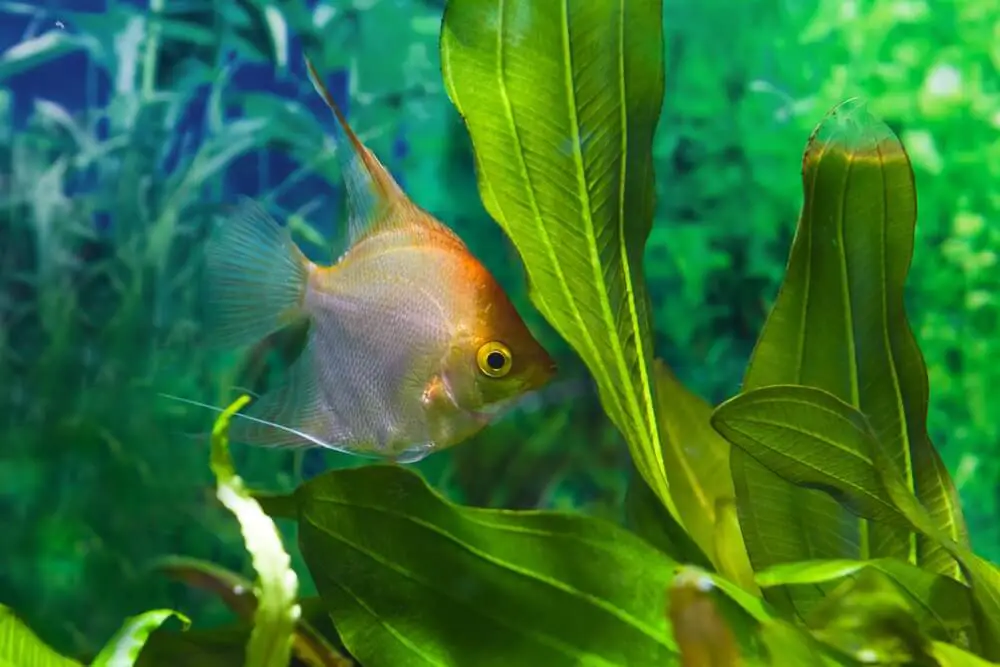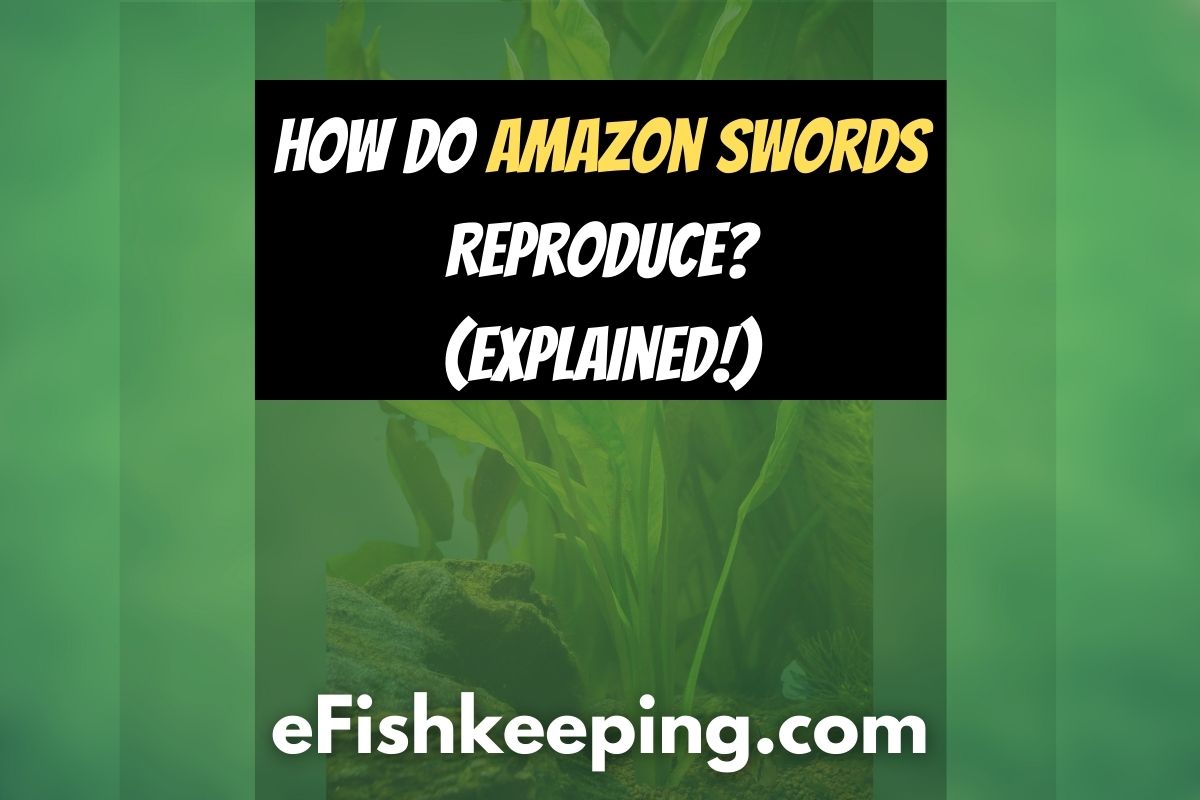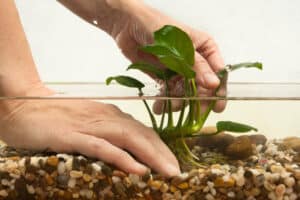Amazon Swords are an amazing aquatic plant, often used to create a thick forest-like effect in freshwater aquariums. Once planted in a loose substrate and given the proper nutrition, they can spread to create a beautiful underwater vista, or stand as solitary growths to catch the eye.
Amazon Swords reproduce through sending out a single stem, which puts out runners. The runners will put out shoots, which have the potential to become new Amazon Sword plants.

This article looks at not just how the Amazon Sword reproduces, but how you can cultivate the plant and help it thrive.
1. How Do Amazon Swords Reproduce?
Amazon Swords reproduce through a single long stem, which puts out runners. As these runners grow and establish themselves, they set down shoots, usually about 3 to 4 inches apart.
Once the shoots are established, they begin to grow and develop a root system of their own.
Once the root system has developed a bit, you can separate the new growth from the runners and transplant it in a new location.
2. How Long Does It Take For An Amazon Sword to Reproduce?
There is no set time frame for your Amazon Sword to start reproducing. Reproduction rates are controlled by a number of factors.
Environmental qualities can affect the growth rate of the Amazon Sword, as well as its reproduction.
Amazon Swords also need time to establish themselves in new surroundings. Root development and plant maturity at the time of transplantation may influence the rate of growth and reproduction as well.
It may take weeks, even months, for your Amazon Sword to begin sending out reproductive runners and new growth. I’d recommend patience while your plant gets settled in the aquarium.
3. How Do I Help the New Amazon Sword Growth Thrive?
Amazon swords thrive the best in loose substrate, with small grain gravel or a professional grade substrate. You can plant them in loose soil or sand, but they may need more tending in that case.
For best results, keep the aquarium water between 72 to 82 degrees Fahrenheit, with a pH balance between 6.5 and 7.5. You should also give your Amazon swords plenty of light exposure – 10 hours or more.
4. How Do I Know If My Plant Is Ready to Propagate?
The Amazon Sword plant usually grows to about 12 inches, though it can grow as high as 20 inches.
Once it reaches about 8-10 inches, it’s mature enough to start reproducing, and another shoot should appear soon after.
It may take a few months for your Amazon Sword to reach this point, since it needs time to firmly establish itself after transplantation.
5. How Do I Get Amazon Sword Runners?
The Amazon Sword should naturally produce runners of its own after it’s grown to the proper height and maturity. If it doesn’t, you can encourage it by trimming it back.
Trimming the leaves and roots back can inhibit growth and encourage it to put out runners and propagate.
6. Is There Anything Else That Might Affect My Amazon Sword Reproducing?
If your Amazon Sword isn’t healthy, it may not send out runners or new shoots.It may need to be nursed back to health before it will put out shoots.
Signs that your Amazon Sword is unhealthy include:
- Yellowing leaves
- Transparent leaves and stalks
- Algae growth on the plant
7. What Can I Do If My Amazon Sword is Showing Signs of Poor Health?
Trim back any yellowing leaves at the base of the plant. Remove any transparent foliage the same way.
Once you’ve removed the dying foliage, check the substrate nutrients and the lighting, as well as the water quality.
The most common reason for slowed growth, lack of propagation, and dying leaves or algae is usually one or these environmental factors.
8. What Should I Do About Algae Growth On My Amazon Sword?
If your Amazon Sword is growing algae, you’ll need to break off any affected leaves at the very base of the plant. You may also need to prune deeper to be sure you get it all.
Once you’ve pruned out the affected foliage, check the water quality, the amount of light available, and the substrate nutrients available.
If all the environmental factors are in the healthy zone for your Amazon Sword, then consider getting aquatic creatures like shrimp, snails, or catfish to consume algae and keep algae growth in check.
9. Can You Divide an Amazon Sword Plant?
Amazon swords often grow from a single focal point, a shoot in the center of the leaves. For this reason, As a general rule of thumb, it’s normally recommended to not divide the plant, as this may damage it.
If you do decide to divide it, be very careful to follow the procedure below:
– Cut through the center of the main shoot and the root mass
– Place one half of the divided plant in the newest location, making sure the substrate has the proper composition.
– Make sure the plant has plenty of nutrients, light, and the proper water temperature and pH balance.
– You may want to add root tabs or nutrient tabs to the substrate to encourage growth.
It can be difficult to get an Amazon Sword plant to grow and reproduce after doing this, but not impossible.
10. What Are the Best Ways to Divide an Amazon Sword Plant?
I recommend waiting until the plant has put out its runner, and new shoots have started to sprout.
Once the new shoots have begun to form their own root systems, you can divide the new growth from the original plant shoot.
Trim the runner to separate the new shoot from the parent plant. Then, if you want, you can transplant the new shoot to the desired location.
11. How Old Should an Amazon Sword Be Before Transplanting After Reproduction?
There’s no set age, but the new shoot should be developed enough to have started developing a root system, but not fully matured and rooted.
Aquarium enthusiasts have had success transplanting a 2 inch ‘young’ plant.
It can be riskier to move a mature Amazon Sword, but it’s possible as long as you’re careful with the root system.
12. Are New Growth Amazon Swords Easy to Care For?
Amazon Swords are a very hardy aquarium plant. As long as conditions are right, they’ll thrive, even after being moved.
The key is to have a deep enough substrate for the root structure to grow and develop properly.
13. Will Amazon Sword Leaves Grow Roots?
In Amazon Swords, the leaves don’t grow roots. Only the central stem, or nub in some cases, will put out the runner from which new growth forms.
Trimming the leaves will not provide material for new plant growth.
14. Can an Amazon Sword Reproduce Outside of the Water?
An Amazon Sword will grow when either fully or partially submerged. However, it doesn’t really grow well when completely out of water.
Since it’s an aquatic plant, it’s unlikely it will reproduce in a non-aquatic environment.
15. How Does the Substrate Affect Amazon Sword Reproduction?
Amazon Swords prefer a loose substrate, either large-grained sand or small-grained gravel.
Larger gravel can be acceptable as a substrate, as long as there’s a denser, nutrient-rich layer beneath the gravel.
If you want to use larger gravel as a substrate, the gravel layer should be shallow enough for another layer to be placed beneath. Ideally, this should be a nutrient rich soil.
If you choose sand, it should be very loosely packed. Sand is also more likely to compress the root system, making it more difficult for the Amazon Sword plants to grow and thrive.
If there aren’t enough nutrients or enough space, the plants may not be rooted or developed enough to reproduce.
16. How Deep Should The Substrate Be for Amazon Sword Plant Reproduction?
I recommend a substrate depth of around 2.5 inches for the best results.
Ideally, the substrate should be deep enough to completely bury the roots and the base of the main stalk. There should also be enough depth to the substrate for the root system to branch out.
17. What Nutrients are Needed to Encourage Amazon Sword Reproduction?
While gravel makes a good substrate, the Amazon Sword does need certain nutrients to thrive. As a general rule of thumb, I recommend adding plenty of root tabs to soil and substrate.
Other recommendations include adding an iron rich fertilizer, replenished every week or when the water is exchanged and filtered.
18. Do Amazon Swords Need CO2 to Develop and Reproduce?
The Amazon Sword plant doesn’t need additional CO2, beyond what naturally occurs. No CO2 tabs are required to encourage healthy growth and reproduction.
The exception would be if there are issues with lighting. An Amazon Sword that doesn’t receive sufficient light may require extra CO2 to be healthy.
19. How Do Light Levels and Exposure Affect Amazon Sword Reproduction?
Light levels will affect CO2, and influence Amazon Sword growth and reproduction.
Too much light can result in extra growth, such as algae, which can damage the plant too much for reproduction to occur.
Too little light can result in an unhealthy plant that doesn’t have enough nutrients to reproduce.
20. What’s the Best Light Level and Duration to Encourage Amazon Sword Reproduction?
I recommend a medium level of light, with somewhere between 10-12 hours of exposure daily.
Recommendations for lights include a specialized plant light, or an LED of appropriate strength.
According to the rule of thumb, the light used should give out approximately 3 watts per gallon.
21. Does the Size of the Tank Affect Amazon Sword Reproduction?
An Amazon Sword plant needs a tank that is both tall enough to achieve optimum growth, and wide enough for propagation.
Including the substrate, this should be a tank that is at least 20 inches tall, for the average Amazon Sword growth.
Amazon Swords like to send out runners that put down shoots every 3-4 inches, so the tank needs to be several inches wide and long.
The minimum recommended tank size is generally about 20 gallons or more. For lighting, a light of 60 watts or so is recommended.
22. Can Certain Aquatic Fauna Encourage or Prevent Amazon Sword Reproduction?
Algae consuming creatures such as snails or shrimp can encourage healthy growth.
As a rule, I recommend avoiding putting goldfish or larger fish in the tank, especially if the plants haven’t had time to fully root themselves.
Larger fish, or fish like goldfish that like eating Amazon Swords can damage the plants beyond the ability to reproduce.
23. Are There Any Other Factors That May Influence Amazon Sword Reproduction Rates?
pH factors and water temperature may also influence growth and reproduction.
Water that’s too cold, too hot, or has an incorrect pH may inhibit growth and discourage reproduction. It may also encourage growth of harmful organisms, like algae.
Final Thoughts:
Once the Amazon Sword reaches 8 to 10 inches, you can start looking for the long-stemmed runners, and the small shoots 3-4 away that indicate new growth. Given the proper environment, these new shoots will grow and reproduce within months, to produce a verdant forest-like undergrowth for your aquarium.
Recommended Read:
Hi! I’m Praveen Ghoshal, the founder of eFishkeeping.com. Inspired by my Dad, I got interested in fishkeeping when I was a kid. Since then, I have been involved with this hobby. Currently, I have 3 fish tanks at our home, and I enjoy this hobby with my full family. Read more about me here.






![Why Are Anubias So Expensive? [Reasons + Cheap Alternatives] why-are-anubias-so-expensive](https://efishkeeping.com/wp-content/uploads/2022/12/anubias-in-a-planted-aquarium-300x200.jpg)
